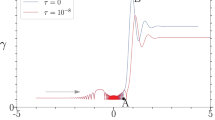Abstract
The existing results on the theory of stochastic cyclic accelerators are extended using the methods of difference equations and random-walk theory. The theoretical guidelines provided by this paper should be sufficient to allow an evaluation of the feasibility of making a practical machine using the principle of stochastic acceleration.
It is found that the average time required for the acceleration of a particle to its final energy is approximately one-third of that in the existing results. It is shown that the diffusion constant in energy space can be very simply expressed in terms of the meansquare voltage applied at the accelerator gap and the bandwidth of the applied-field spectrum for the practical case of interest. The required power input and the resistive input impedance for the accelerator are calculated taking particle losses into account.
Similar content being viewed by others
Author information
Authors and Affiliations
Additional information
I appreciate helpful comments made by Dr. H. M. Mayer and Dr. H. Derfler during the preparation of this manuscript. This work has been performed as part of the joint research programme of the Institut für Plasmaphysik and Euratom.
Rights and permissions
About this article
Cite this article
Puri, S. On the theory of stochastic acceleration of high energy particles in cyclic accelerators. Z. Physik 233, 358–367 (1970). https://doi.org/10.1007/BF01397795
Received:
Published:
Issue Date:
DOI: https://doi.org/10.1007/BF01397795




